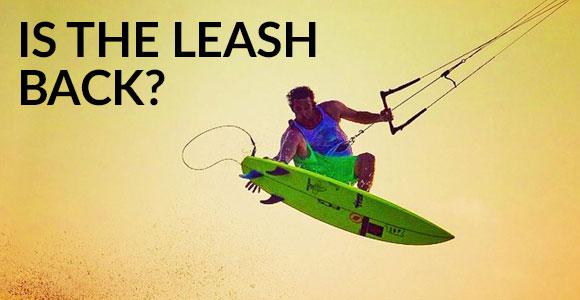
Editor’s Note: In this article, we are talking about surfboard leashes being used in kitesurfing. We are NOT talking about retractable webbing leashes being used in kitesurfing, or surfboard leashes being used on twin tips. Before you yell at us and say we are going to die, please read the entire article. Thanks! -Ed.
Kiteboarding gear trends often move in circles. One piece of gear that was present during the early days of kiteboarding was the board leash. When kites did not depower or go upwind easily, a board leash was a very useful piece of equipment. As kites evolved with better depower and flew easier upwind, kiters could more easily recover their board and the need for a leash was reduced. As horror stories of board-leash related injuries began to pile up (the tension on the leash can cause the board to fly back and hit you), it seemed the kite community generally agreed that board leashes should not be used, and if you did use a board leash then wearing a helmet was mandatory.

“In the early days of kiting, let’s say 1998 – 2001, we wore surfboard leashes when kiting on our directional kitesurf boards. These leashes were standard surf leashes like what surfers use when they paddle surf. When we got pulled really hard by the 2-line or early 4-line kites, the boards would tombstone to the bottom and the leash would double in length. Sometimes the leash would break and other times it would recoil, like the board was shot out of a cannon…right at our head.” – Trip Forman
Fast-forward 10+ years and kiteboarders are now progressing into strapless wave riding quicker than ever before. The newer user-friendly kite designs allow any kiter with intermediate or above skills to mix it up in the surf and try riding waves on their kite. As “kitesurfers” explored new locations and favorite surf spots in their quest for the perfect combo of wind and waves, they came upon situations where wearing a leash was the safest and most logical way to pull off a session…
Some surf breaks have shallow reef or rock zones where you simply can’t body drag in to retrieve your board. Even at the friendlier sand-bottomed beach breaks, the number of kitesurfers in the water can make body-dragging around for your board a huge inconvenience to everyone else in the water.
“We started kitesurfing West Point in Anegada in 2005 and learned quickly that you have to wear a surf leash there. The wind is side-offshore and there is a nearly dry reef on the inside. If you lose your board, it will wash over the dry reef and get stuck on the inside. The wind direction and dry reef make it impossible to retrieve the board without someone else getting it with a dinghy. If you were riding by yourself, the only exit would be body dragging to Tortola, roughly 15 miles downwind. Yep, wearing a leash there is definitely a requirement!” – Trip Forman

For any session, there are great reasons both for and against wearing a board leash. The important thing to remember is a leash is never an excuse to charge into conditions you aren’t ready for. A leash is an optional tool for the experienced kitesurfer, and should only be used in situations where it’s important that you don’t become separated from your board. If you’re considering adding a leash to your kitesurfing kit, take a practice session in flat water to get used to depowering your kite when you fall. You should also practice how to quickly take the leash off your ankle for emergencies. We always recommend a traditional urethane cord surf leash (rather than a webbing leash), because it is likely to break under extreme loads rather than holding strong and injuring the rider. Most riders are using a 6ft’ long by ¼” thick surf leash with their kitesurf boards of similar length.
Browse all leashes on REALwatersports.com
“In bigger surf, my surfboard leash is my absolutely, #1 favorite piece of kiteboarding equipment ever. You can hit the lip as hard (and as late) as you want and if you don’t make it, you don’t have to go for a 10-minute body drag looking for your board. On the way out through the surf, you can also opt to dive off your board underneath a wave and let it roll over you and your board. Once out the other side, simply pull the board back to you and board-start away. You can even use the pull of the kite (low) to get you under and past the wave, and then angle it up to pull you back to the surface as the wave rolls over you and past.” – Trip Forman
For beginner kiteboarders and twin-tip riders, the best thing you can do is NOT use a leash and perfect your upwind body drag! Solid body drag skills will not only help you retrieve your board, but will also keep you out of all types of dangerous situations. For advanced wave riders, strap on the surfboard leash and enjoy the added confidence when charging big offshore waves, rock/reef breaks, or crowded lineups!

“Check yourself before you wreck yourself…..In order to use a surfboard leash effectively and not have your board become a ballistic missile aimed at your head, you need to be able to simultaneously fall and keep your kite “quiet” in the sky at the edge of the window. If you’re falling and then looping your kite out of control – the surfboard leash is not for you – you will get hurt. If you can fall and simultaneously depower your kite by pushing the bar away and keeping your kite steady, then the surfboard leash will save you a TON of swimming and searching, plus add a lot more fun to each kitesurf session.” – Trip Forman

